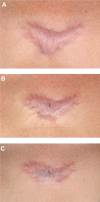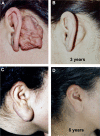Management of keloids and hypertrophic scars: current and emerging options
- PMID: 23637546
- PMCID: PMC3639020
- DOI: 10.2147/CCID.S35252
Management of keloids and hypertrophic scars: current and emerging options
Abstract
In the context of growing aesthetic awareness, a rising number of patients feel disappointed with their scars and are frequently seeking help for functional and aesthetic improvement. However, excessive scarring following surgery or trauma remains difficult to improve despite a plethora of advocated treatment strategies as frequently observed in daily clinical routine. It is thus still preferable to prevent scarring by minimizing risk factors as much as possible. Hence, it remains crucial for the physician to be aware of basic knowledge of healing mechanisms and skin anatomy, as well as an appreciation of suture material and wound closure techniques to minimize the risk of postoperative scarring. Next to existing, well known prophylactic and therapeutic strategies for the improvement of excessive scarring, this article discusses emerging techniques such as intralesional cryotherapy, intralesional 5-fluorouracil, interferon, and bleomycin. Some of them have been successfully tested in well-designed trials and already have extended or may extend the current spectrum of excessive scar treatment in the near future. Innovative options such as imiquimod 5% cream, photodynamic therapy, or botulinum toxin A may also be of certain importance; however, the data currently available is too contradictory for definite recommendations.
Keywords: TGF-β; intralesional cryotherapy; lasers; triamcinolone acetonide.
Figures




References
-
- Tredget EE, Nedelec B, Scott PG, Ghahary A. Hypertrophic scars, keloids, and contractures. The cellular and molecular basis for therapy. Surg Clin North Am. 1997;77(3):701–730. - PubMed
-
- Niessen FB, Spauwen PH, Schalkwijk J, Kon M. On the nature of hypertrophic scars and keloids: a review. Plast Reconstr Surg. 1999;104(5):1435–1458. - PubMed
-
- Slemp AE, Kirschner RE. Keloids and scars: a review of keloids and scars, their pathogenesis, risk factors, and management. Curr Opin Pediatr. 2006;18(4):396–402. - PubMed
-
- Gauglitz GG, Pavicic T. [Emerging strategies for the prevention and therapy of excessive scars.] MMW Fortschr Med. 2012;154(15):55–58. German. - PubMed
LinkOut - more resources
Full Text Sources
Other Literature Sources

